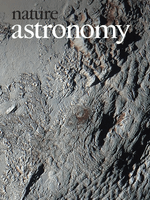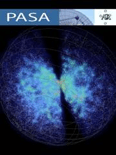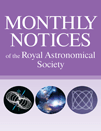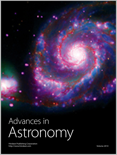
Nature Astronomy
Scope & Guideline
Navigating New Frontiers: Essential Research for Tomorrow's Astronomers.
Introduction
Aims and Scopes
- Exoplanetary Science:
This area encompasses the study and characterization of exoplanets, including their atmospheres, compositions, and potential habitability, utilizing advanced observational techniques like JWST. - Astrobiology:
Research in astrobiology focuses on the origins, evolution, and potential for life beyond Earth, examining environmental conditions and biosignatures on other planets and moons. - Galactic and Extragalactic Astronomy:
The journal publishes studies on galaxy formation, evolution, and the role of dark matter, as well as the dynamics and interactions of galaxies within the universe. - Cosmology and Fundamental Physics:
Papers in this domain explore the structure and evolution of the universe, including dark energy, gravitational waves, and the fundamental laws of physics. - Planetary Science and Solar System Exploration:
This scope includes investigations into planetary bodies within our solar system, focusing on their geology, atmospheres, and the processes influencing their evolution. - Astrophysical Phenomena:
Research on high-energy astrophysical phenomena such as supernovae, black holes, and gamma-ray bursts, which provide insights into extreme physical conditions and cosmic events. - Instrumentation and Methodological Advances:
Nature Astronomy highlights innovative methodologies, including machine learning and advanced observational techniques, that enhance data collection and analysis in astronomy.
Trending and Emerging
- Machine Learning Applications:
The integration of machine learning techniques in data analysis and astronomical research has surged, facilitating advancements in areas such as exoplanet discovery and astrophysical modeling. - High-energy Astrophysics:
There is an increasing focus on high-energy astrophysical phenomena, including gravitational waves and gamma-ray bursts, driven by new observational capabilities and theoretical developments. - Planetary Habitability Studies:
Research into the conditions necessary for life, particularly on exoplanets and moons within our solar system, is gaining momentum as new data becomes available from missions like JWST. - Interstellar and Cosmic Chemistry:
Emerging studies on the chemical processes in interstellar space and their implications for the origins of life are becoming more prevalent, reflecting a growing interest in astrobiological contexts. - Dark Matter and Energy Research:
Research into dark matter and energy, including their implications for cosmology and galaxy formation, continues to trend upward as new observational data challenges existing theories.
Declining or Waning
- Solar System Geology:
While still present, the frequency of studies specifically focused on detailed geological processes of solar system bodies has decreased, possibly due to a shift towards exoplanetary research. - Classical Stellar Astrophysics:
Research dedicated to classical stellar evolution and dynamics appears to be diminishing as newer methodologies and technologies shift attention to more complex astrophysical phenomena. - Traditional Cosmological Models:
There is a noticeable waning interest in traditional cosmological models that do not incorporate new findings related to dark matter and dark energy, as attention shifts toward more complex models. - Historical Astronomy:
Papers focusing on the historical aspects of astronomy and its development have become less frequent, as the journal emphasizes contemporary and forward-looking research.
Similar Journals

PUBLICATIONS OF THE ASTRONOMICAL SOCIETY OF AUSTRALIA
Pioneering Research in the Vastness of Space.Publications of the Astronomical Society of Australia, published by Cambridge University Press, stands as a distinguished platform for advancing knowledge in the realms of Astronomy, Astrophysics, Space, and Planetary Science. Hemmed in the United Kingdom, this journal is recognized for its outstanding contributions, reflected in its status as a Q1 journal in both Astronomy and Astrophysics, along with Space and Planetary Science categories as of 2023. With a solid impact factor, it ranks impressively at #23 within its Scopus category, firmly placing it in the competitive 75th percentile. This publication facilitates open discourse and innovative research from its inception in 1996 to the present year of 2024, providing an essential resource for researchers, professionals, and students eager to deepen their understanding of cosmic phenomena. By embracing rigorous peer-review standards and a commitment to scholarly excellence, the journal not only contributes to the scientific community but also fosters the next generation of astronomical research.

REVISTA MEXICANA DE ASTRONOMIA Y ASTROFISICA
Illuminating the Universe, One Study at a TimeRevista Mexicana de Astronomía y Astrofísica, published by the Universidad Nacional Autónoma de México (INSTITUTO DE ASTRONOMÍA), is a prominent academic journal dedicated to advancing the knowledge and understanding of astronomy and astrophysics. As a Q3-ranked journal in both Astronomy and Astrophysics, and Space and Planetary Science in 2023, it serves as an invaluable platform for researchers and professionals within these fields. With an ISSN of 0185-1101, this journal seeks to foster innovative research and dialogue among scholars, presenting groundbreaking studies spanning from theoretical astrophysics to observational astronomy. Although it does not operate under an open-access model, the journal remains vital for its contributions to scientific literature from Mexico, with articles converging over several decades from 1996 to 2024. By offering insights into the latest findings and methodologies, Revista Mexicana de Astronomía y Astrofísica not only enhances the academic landscape but also inspires future generations of scientists and students passionate about unraveling the mysteries of the universe.

MONTHLY NOTICES OF THE ROYAL ASTRONOMICAL SOCIETY
Charting New Frontiers in Astrophysical Research.The MONTHLY NOTICES OF THE ROYAL ASTRONOMICAL SOCIETY (MNRAS), published by Oxford University Press, serves as a premier platform for the dissemination of significant research in the fields of Astronomy, Astrophysics, and Space and Planetary Science. Established in 1913 and with an impressive impact factor reflected in its 2023 Q1 rankings—13th in Earth and Planetary Sciences and 14th in Physics and Astronomy—this journal is renowned for its rigorous peer-reviewed articles, fostering advancements in our understanding of the universe. Researchers, professionals, and students alike benefit from its rich content, which spans a vast array of topics within its scope, from stellar dynamics to planetary formation. While the journal does not currently offer Open Access options, the scholarly contributions published herein are invaluable for pushing the boundaries of contemporary scientific inquiry and ensuring that the latest findings reach an engaged audience globally.

EXPERIMENTAL ASTRONOMY
Illuminating the Cosmos with Rigorous ResearchEXPERIMENTAL ASTRONOMY, published by Springer, stands as a pivotal journal in the fields of Astronomy and Astrophysics as well as Space and Planetary Science. With an impressive Scopus ranking and a Q2 category as of 2023, the journal is recognized for its impactful contributions to experimental techniques and observations in astronomy. Covering a broad spectrum of topics from cosmic phenomena to planetary exploration, it serves as a vital platform for researchers, professionals, and students to disseminate and discuss innovative ideas and findings. The journal has evolved through various convergence years since its inception in 1989 and continues to thrive, fostering an environment for academic pursuit and collaboration. Though not an open-access journal, its rigorous peer-review process ensures high-quality publications that are essential for advancing the scientific community's understanding of the universe.

Galaxies, published by MDPI, is a premier open-access journal dedicated to the vibrant field of Astronomy and Astrophysics. Established in 2013, with a strong commitment to making scientific research accessible, this journal has quickly garnered recognition, achieving a notable impact factor and ranking in the Q2 Quartile of its category as of 2023. With a Scopus ranking of #31 out of 90 in the domain of Astronomy and Astrophysics, and a commendable percentile rank of 66, Galaxies serves as a vital platform for researchers, professionals, and students engaged in astronomical studies and related fields, facilitating the dissemination and discussion of groundbreaking research. The journal covers a wide array of topics including galactic dynamics, cosmology, and observational astronomy, encouraging interdisciplinary collaboration and innovation within the scientific community. Located in Basel, Switzerland, and adhering to the highest publishing standards, Galaxies is committed to enriching the academic discourse in astronomy, making a significant impact on both current and future explorations of our universe.

Advances in Astronomy
Advancing Knowledge in Celestial Science and Beyond.Advances in Astronomy is a prestigious open-access journal published by HINDAWI LTD, dedicated to the field of astronomy and astrophysics. Established in 2008, the journal aims to disseminate significant research findings and advancements in the understanding of celestial phenomena, planetary sciences, and the intricate workings of the universe. With an impact factor that reflects its relevance in the scholarly community, Advances in Astronomy holds a commendable rank of Q3 in both Astronomy and Astrophysics as well as Space and Planetary Science categories, indicating its importance within these fields. The journal also showcases a commitment to open-access publishing, ensuring that research is readily available to both the scientific community and the public. Researchers, professionals, and students alike are encouraged to contribute to this dynamic forum to share knowledge and foster collaboration in exploring the wonders of the cosmos.

INTERNATIONAL JOURNAL OF MODERN PHYSICS D
Elevating Research Standards in Modern PhysicsWelcome to the INTERNATIONAL JOURNAL OF MODERN PHYSICS D, a premier publication dedicated to the advancement of knowledge in the fields of Astronomy and Astrophysics, Mathematical Physics, and Space and Planetary Science. Published by WORLD SCIENTIFIC PUBL CO PTE LTD in Singapore, the journal boasts an impressive impact, being ranked Q2 in Astronomy and Astrophysics and Mathematical Physics, and Q3 in Space and Planetary Science. With a converged publishing timeline from 1996 to 2024, this journal provides a vital platform for researchers and professionals to disseminate their findings, engage with cutting-edge research, and explore emerging ideas in modern physics. Although it operates under a traditional access model, the rigorous peer-reviewed process ensures that only the highest quality research contributes to the collective understanding of our universe. Join us in advancing the frontiers of physics and astronomy!

JOURNAL OF ASTROPHYSICS AND ASTRONOMY
Advancing Knowledge in Celestial Science.JOURNAL OF ASTROPHYSICS AND ASTRONOMY, published by the Indian Academy of Sciences, stands as a pivotal resource for researchers and professionals in the fields of astrophysics and astronomy, with a rich history of publication dating back to 1980. This esteemed journal aims to disseminate high-quality research, fostering advancements in how we understand celestial phenomena, space environments, and planetary sciences. With a current Impact Factor that places it in the Q3 category for both Astronomy and Astrophysics and Space and Planetary Science, it maintains a crucial role in the global academic community, particularly within India. Although not an open access journal, its scholarly contributions are vital for both emerging and established researchers striving to push the boundaries of our knowledge in the cosmos. The journal is indexed in Scopus, ranking 56th in Astronomy and Astrophysics and 72nd in Space and Planetary Science, reflecting its ongoing significance and reach in the scientific dialogue.

Gravitation & Cosmology
Exploring the Mysteries of the UniverseGravitation & Cosmology is a vital academic journal founded to explore the profound concepts of gravitation and the dynamics of the universe. Published by MAIK NAUKA/INTERPERIODICA/SPRINGER, this journal features a comprehensive range of research articles, reviews, and theoretical insights that advance the field of astronomy and astrophysics. With a current impact factor reflective of its esteemed contribution, Gravitation & Cosmology operates within the upper tier of its discipline, classified as Q3 in Astronomy and Astrophysics for 2023. Although not an open-access publication, the journal fosters a vibrant community of scholars and practitioners by providing rigorous peer-reviewed content accessible through various academic platforms. Covering converged years from 2008 to 2024, this journal serves as an indispensable resource for anyone keen on deepening their understanding of gravitational phenomena and cosmological theories. Researchers, professionals, and students alike will find valuable insights and innovative research that push the boundaries of contemporary astrophysical knowledge.

Journal of Cosmology and Astroparticle Physics
Pioneering Insights into Dark Energy and Particle PhysicsThe Journal of Cosmology and Astroparticle Physics (ISSN: 1475-7516) is a premier publication in the field of astronomy and astrophysics, dedicated to advancing our understanding of the cosmos through innovative research. Published by IOP Publishing Ltd in the United Kingdom, this journal has established itself as a vital resource for researchers, professionals, and students alike, with an impressive Scopus rank of #11/90, placing it in the top 12% of its field. The journal aims to foster the dissemination of groundbreaking studies related to cosmology, dark energy, particle physics, and the universe's fundamental structure, making it a key player in shaping contemporary astrophysics discourse. With a Category Quartile of Q2 as of 2023, it continues to attract high-quality contributions that enhance scholarly dialogue. As an accessible platform, it engages a diverse audience interested in the frontiers of astrophysical research, encouraging collaboration and knowledge sharing among the global scientific community.